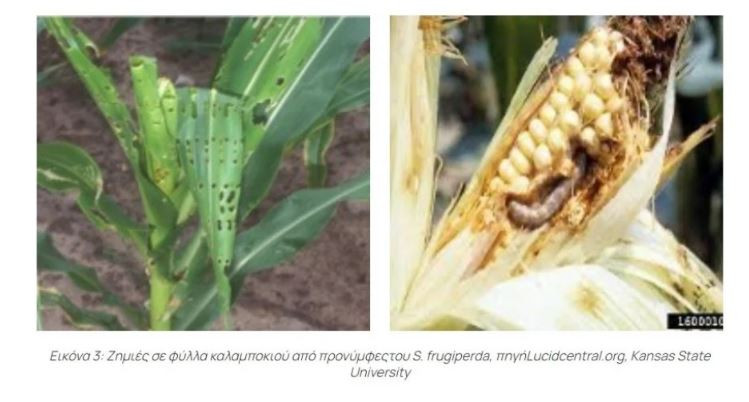The butterfly in question has been confirmed to have been spotted in the Units of Laconia, Heraklion, Lasithi, Eastern Attica, Evia and Lesvos and Chania.
The Region of Attica issued a notice about an extremely harmful to crops butterfly called Spodoptera frugiperda first appeared in Greece in September 2023 and since then until now it has been detected in 7 regions of the country causing a “headache” to farmers.
In total, more than 350 plant species have been recorded that are affected by Spodoptrea frugiperda, which, however, is more common in herbaceous plants of the grass family, such as corn, sorghum, cereals, rice, grass, etc., significantly reducing production.
It can also cause significant damage to crops such as cotton, cucurbits, rapes, peanuts, alfalfa, onions, beans, tomatoes, eggplants, peppers.
The butterfly in question has been confirmed to have been spotted in the Units of Laconia, Heraklion, Lasithi, Eastern Attica, Evia and Lesvos and Chania.
The insect lays its eggs at night, depositing its eggs in clusters of 150-200 eggs on the lower leaves of plants. Each female can deposit more than 1,000 eggs.
The eggs are covered with a yellow to pink protective material produced by the female insects (image 1).
After 2-3 days the larvae (caterpillars) hatch from the eggs, which at first are green in color with a black head (picture 2).
In their first age stages they feed on the lower surface of the leaves, causing characteristic damage. As they grow, they turn brown, exhibit cavalier behavior and consume entire sections of the leaves.
The last instar larvae are nocturnal, cause general defoliation of plants and can migrate long distances in search of new crops.
As soon as the larva completes its development, it falls to the ground and at a depth of 2-8 cm forms a nymph cell made of soil and silk threads, within which it turns into a nymph. The nymphs have a bright brown coloration.
The final insect that will emerge has two different leaves (male, female), has a body length of about 1.6 cm and gray-brown wings (images 5, 6).
During the hot summer months the biological cycle is completed in 30 days, while in colder seasons it lasts from 60 to 90 days. It does not exhibit the phenomenon of diapause, so it is active throughout the year, weather permitting. Just before the new insects start laying eggs they fly and can travel several kilometers.
To prevent the introduction, establishment and spread of Spodoptera frugiperda in the territory of the Union the European Commission has established special measures in accordance with the executive regulation (EU) 2023/1134.
To eliminate (Article 9 of CAN. (EU) 2023/1134) the harmful organism S. frugiperda in the affected areas the following measures should be taken:
1. Interventions with plant protection products approved against the harmful organism
2. Taking measures to avoid the transfer of soil from fields in which its presence has been established, and prohibiting the movement of topsoil and used growing substrates outside the affected zone
3. Diligent cleaning of agricultural machinery and taking hygiene measures in the packing houses
4. Taking measures to destroy weeds and native vegetation by plowing or spraying with appropriate plant protection preparations, in cases where the presence of S. frugiperda is established in abandoned fields or on native plants within crops.
5. Frequent and regular inspection of greenhouses and nurseries and immediate notification of the responsible phytosanitary services and application of plant protection products in cases where the presence of S. Frugiperda is found.
6. It is pointed out that, in accordance with articles 14 and 15 of Regulation (EU) 2016/2031, in any case the professional or other person is obliged to notify the presence of suspicious symptoms or individuals (egg masses, larvae, nymphs, adults) to the local phytosanitary service. The non-compliance of the obligees with the instructions of the phytosanitary services constitutes a phytosanitary violation and the provisions of articles 34a and 35 of Law 2147/1952 (A’ 155) apply.
Also, according to article 11 of the Civil Code. 2023/1134 the transaction:
fruits of the species Capsicum (pepper), Momordica L., Solanum aethiopicum L., Solanum macrocarpon L. and Solanum melongena (eggplant)
plants of the species Asparagus officinalis L., excluding stems covered with soil throughout their life, live pollen, plants in tissue culture and seeds
plants of the species Zea mays L., other than live pollen, plants in tissue culture, seeds and grains
plants of the species Chrysanthemum L., Dianthus L. and Pelargonium l’Hérit. ex Ait., excluding seeds
which spent a part of their life in demarcated areas outside the demarcated areas will only be possible if they are accompanied by a phytosanitary passport.
Source: Skai
I have worked as a journalist for over 10 years, and my work has been featured on many different news websites. I am also an author, and my work has been published in several books. I specialize in opinion writing, and I often write about current events and controversial topics. I am a very well-rounded writer, and I have a lot of experience in different areas of journalism. I am a very hard worker, and I am always willing to put in the extra effort to get the job done.













